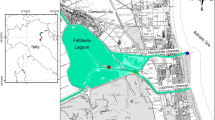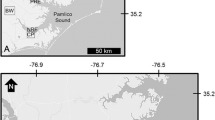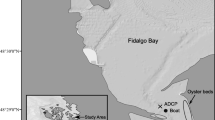Abstract
Choked lagoons (like Mar Chiquita, Argentina) are influenced by local winds because the inlet channel acts as a dynamic filter which reduce tidal fluctuations. Previous studies showed that the effects of onshore winds appear to prevail over daily-tide cycles (ebb, flood) in the recruitment of young fishes into this micro-tidal and shallow estuary. Therefore, the aim of this study was to evaluate the recruitment success of larval and juvenile fishes from the sea into this choked lagoon related to the conjunction of global (lunar-tide cycle) and local (wind regime) processes. Weekly fish sampling was conducted in Mar Chiquita’s inlet channel and its adjacent surf zone from early spring to late summer. For each fish developmental stage (i.e. larval and juvenile), a multiple-hypothesis model approach was adopted by fitting generalized linear models (GLM) with the abundance of fishes as the response variable and possible combinations of seasons, sites, water parameters and the wind effect as explanatory variables. The abundances of fish larvae and juveniles were mainly affected by wind regimen and seasonal changes according to the best model selected. Larval and juvenile fishes were more abundant at summer months during strong (> 10 m · s−1) onshore wind episodes. The lunar-tide cycle effect was not relevant for the success of fish recruitment. Despite its seasonal regularity, wind is a much more unpredictable factor than tides, and therefore, it is remarkable to note the implications that have for fishes the recruitment towards an estuarine system depending on such unpredictable force. The importance of the fish nursery role of the coastal area close to the mouth of an estuary with this environmental feature is discussed.




Similar content being viewed by others
References
Blaber SJM, Blaber TG (1980) Factors affecting the distribution of juvenile estuarine and inshore fish. J Fish Biol 17:143–162
Blaber SJM, Brewer DT, Salini JP (1989) Species composition and biomasses of fishes in different habitats of a tropical Northern Australian estuary: their occurrence in the adjoining sea and estuarine dependence. Estuar Coast Shelf Sci 29:509–531
Blasina GE, Delpiani SM, Bruno DO, González-Castro M, Díaz de Astarloa JM (2009) First record of Callorhinchus callorynchus and Trachurus lathami, in a south-western Atlantic coastal lagoon. Mar Biodivers Rec 2(e90):1–3
Boehlert GW, Mundy BC (1988) Roles of behavioral and physical factors in larval and juvenile fish recruitment to estuarine nursery areas. Am Fish Soc Symp 3:51–67
Bruno DO (2014) Patrones de utilización de la laguna Mar Chiquita (Buenos Aires, Argentina) y área costera adyacente por parte de los primeros estadios ontogénicos de peces. Universidad Nacional de Mar del Plata
Bruno DO, Addino M, Díaz de Astarloa JM (2011) Southernmost occurrence of Syngnathus folletti on a temperate coastal lagoon of Argentina. Mar Biodivers Rec 4(e62):1–3
Bruno DO, Barbini SA, Díaz de Astarloa JM, Martos P (2013) Fish abundance and distribution patterns related to environmental factors in a choked temperate coastal lagoon (Argentina). Braz J Oceanogr 61:43–53
Bruno DO, Delpiani SM, Cousseau MB, de Astarloa JM D, Blasina GE, Mabragaña E, Acha EM (2014) Ocean-estuarine connection for ichthyoplankton through the inlet channel of a temperate choked coastal lagoon (Argentina). Mar Freshw Res 65(12):1116–1130
Burnham KP, Anderson DR (2002) Model selection and multimodel inference: a practical information theoretic approach. Springer, New York
Burnham KP, Anderson DR (2004) Multimodel inference: understanding AIC and BIC in model selection. Sociol Methods Res 33:261–304
Cousseau MB, Díaz de Astarloa JM, Figueroa DE (2001) La Ictiofauna de la Laguna Mar Chiquita. In: Iribarne O (ed) Reserva de Biósfera Mar Chiquita: Características físicas, biológicas y ecológicas. Editorial Martín, Mar del Plata, pp 187–203
Cowley PD, Whitfield AK, Bell KNI (2001) The surf zone ichthyoplankton adjacent to an intermittently open estuary, with evidence of recruitment during marine over wash events. Estuar Coast Shelf Sci 52:339–348
Crawley MJ (2005) Statistics: an introduction using R. Wiley, Chichester
Day JW Jr, Hall CAS, Kemp WM, Yáñez-Arancibia A (1989) Estuarine ecology. Wiley, New York
Delpiani SM, Bruno DO, Díaz de Astarloa JM, Acuña F (2012) Development of early life stages of the blenny Hypleurochilus fissicornis (Blenniidae). Cybium 36(2):357–359
Díaz de Astarloa JM, Figueroa DE, Cousseau MB, Barragán M (2000) Occurrence of Trachinotus carolinus (Carangidae) in laguna costera Mar Chiquita, with comments on other occasionally recorded fishes in Argentinean waters. Bull Mar Sci 66:399–403
Epifanio CE, Garvine RW (2001) Larval transport on the Atlantic continental shelf of North America: a review. Estuar Coast Shelf Sci 52:51–77
Figueroa DE, Díaz de Astarloa JM, Cousseau MB (2000) Southernmost occurrence of the aguavina on the western Atlantic coast of Argentina. J Fish Biol 56:1280–1282
Forward RB Jr, Reinsel KA, Tankersley RA, Churchill JH, Crowder LB, Hettler WF, Warlen SM, Green MD (1999) Transport of fish larvae through a tidal inlet. Fish Oceanogr 8:153–172
Franklin AB, Shenk TM, Anderson DR, Burnham KP (2001) Statistical model selection: An alternative to null hypothesis testing. In: Shenk TM, Franklin AB (eds) Modeling in natural resource management. Development, interpretation and application. Island Press, Washington DC, pp 75–90
González-Castro M, Díaz de Astarloa JM, Cousseau MB (2006) First record of a tropical affinity mullet, Mugil curema (Mugilidae), in a temperate southwestern Atlantic coastal lagoon. Cybium 30:90–91
González-Castro M, Díaz de Astarloa JM, Cousseau MB, Figueroa DE, Delpiani SM, Bruno DO, Guzonni JM, Blasina GE, Deli-Antoni MY (2009) Fish composition in a south-western Atlantic temperate coastal lagoon: spatial-temporal variation and relationships with environmental variables. J Mar Biol Assoc U K 89:593–604
Greenwood MFD, Hill AS (2003) Temporal, spatial and tidal influences on benthic and demersal fish abundance in the Forth estuary. Estuar Coast Shelf Sci 58:211–225
Hampel H, Cattrijjse A, Vincx M (2003) Tidal, diel and semi-lunar changes in the faunal assemblage of an intertidal salt marsh creek. Estuar Coast Shelf Sci 56:795–805
Houde ED (2002) Chapter 3: mortality. In: Fuiman LA, Werner RG (eds) Fishery science: the unique contributions of early life stages. Blackwell Science, Oxford, pp 64–87
Islam MS, Hibino M, Tanaka M (2007) Tidal and diurnal variations in larval fish abundance in an estuarine inlet in Ariake Bay, Japan: implication for selective tidal stream transport. Ecol Res 22:165–171
Jager Z (1999) Selective tidal stream transport of flounder larvae (Platichthys flesus L.) in the Dollard (Ems Estuary). Estuar Coast Shelf Sci 49:347–362
Johnson JB, Omland KS (2004) Model selection in ecology and evolution. Trends Ecol Evol 19:101–108
Jones CM (2002) Chapter 2: age and growth. In: Fuiman LA, Werner RG (eds) Fishery science: the unique contributions of early life stages. Blackwell Science, Oxford, pp 33–63
Kjerfve B (1994) Coastal lagoons. In: Kjerfve B (ed) Coastal lagoon processes. Elsevier Oceanography Series 60, Amsterdam, pp 1–8
Kjerfve B, Magill KE (1989) Geographic and hydrodynamic characteristics of shallow coastal lagoons. Mar Geol 88:187–199
Kneib RT, Wagner SL (1994) Nekton use of vegetated marsh habitats at different stages of tidal inundation. Mar Ecol Prog Ser 106:227–238
Lenanton RCJ, Potter IC (1987) Contribution of estuaries to commercial fisheries in temperate Western Australia and the concept of estuarine dependence. Estuaries 10:28–35
Marcovecchio J, Freije H, De-Marco S, Gavio A, Ferrer L, Andrade S, Beltrame O, Asteasuain R (2006) Seasonality of hydrographic variables in a coastal lagoon: Mar Chiquita, Argentina. Aquatic Conserv Mar Freshw Ecosyst 16:335–347
Martinetto P, Ribeiro P, Iribarne O (2007) Changes in distribution and abundance of juvenile fishes in intertidal soft sediment areas dominated by the burrowing crab Chasmagnathus granulatus. Mar Freshw Res 58:194–203
Martino EJ, Able KW (2003) Fish assemblages across the marine to low salinity transition zone of a temperate estuary. Estuar Coast Shelf Sci 56:969–987
Martos P, Reta R, Guerrero RA (2004) El ambiente físico de las costas marplatenses: su clima y sus aguas. In: Boschi EE, Cousseau MB (eds) La vida entre mareas: vegetales y animales de las costas de Mar del Plata, Argentina. Publicaciones especiales INIDEP, Mar del Plata, pp 29–42
Merlotto A, Bértola G (2009) Coastline evolution at Balneario Parque Mar Chiquita, Argentina. Cienc Mar 35:271–286
Miller JM, Crowder LB, Moser ML (1985) Migration and utilization of estuarine nurseries by juvenile fishes an evolutionary perspective. Contrib Mar Sci 27:338–352
Morrison MA, Francis MP, Hartill BW, Parkinson DM (2002) Diurnal and tidal variation in the abundance of fish fauna of a temperate tidal mudflat. Estuar Coast Shelf Sci 54:793–807
Potter IC, Beckley LE, Whitfield AK, Lenanton RCJ (1990) Comparisons between the roles played by estuaries in the life cycles of fishes in temperate Western Australia and Southern Africa. Environ Biol Fish 28:143–178
Potter IC, Bird DJ, Claridge PN, Clarke KR, Hyndes GA, Newton LC (2001) Fish fauna of the Severn Estuary. Are there long-term changes in abundance and species composition and are the recruitment patterns of the main marine species correlated? J Exp Mar Biol Ecol 258:15–37
Primo AL, Azeiteiro UM, Marques SC, Ré P, Pardal MA (2012) Vertical patterns of ichthyoplankton at the interface between a temperate estuary and adjacent coastal waters: Seasonal relation to diel and tidal cycles. J Mar Syst 95:16–23
R Development Core Team (2012) R: a language and environment for statistical computing. R Foundation for Statistical Computing (Version 2.14.2). Available at http://www.R-project.org/
Reta R, Martos P, Perillo GME, Piccolo MC, Ferrante A (2001) Características hidrográficas del estuario de la laguna Mar Chiquita. In: Iribarne O (ed) Reserva de Biósfera Mar Chiquita: Características físicas, biológicas y ecológicas. Editorial Martín, Mar del Plata, pp 31–52
Rozas LP (1995) Hydroperiod and its influence on nekton use of the salt marsh: a pulsing ecosystem. Estuaries 18:579–590
Schultz ET, Lwiza KMM, Fencil MC, Martin JM (2003) Mechanisms promoting upriver transport of larvae of two fish species in the Hudson River estuary. Mar Ecol Prog Ser 251:263–277
Venables WN, Ripley BD (2002) Modern applied statistics with S-Plus. Springer, New York, p 584
Ward E (2008) A review and comparison of four commonly used Bayesian and maximum likelihood model selection tools. Ecol Model 211:1–10
Weinstein MP, Weiss SL, Hodson RG, Gerry LR (1980) Retention of three taxa of postlarval fishes in an intensively flushed tidal estuary, Cape Fear River, North Carolina. Fish Bull 78:419–436
Acknowledgments
We express our gratitude to Buenos Aires Province Ministry of Agrarian Subjects’ authorities, M. Iza and J. Mangiarotti (forest guard of Mar Chiquita Biosphere Reserve) for sampling permission; to S.M. Delpiani, G.E. Blasina, L.B. Sansosti, R.D. Becerra, H.P. Lértora, D. Rodríguez-Golpe, M.Y. Deli-Antoni and F. Sala, for field assistance; and to A.T. Gómez (National Weather Service, Argentina) who kindly provided rainfall and wind data. We also acknowledge S.A. Barbini, M.B. Cousseau and anonymous reviewers for useful comments on an early draft. D.O.B. was supported by fellowships from CONICET (Argentina). This is part of D.O.B’s Ph.D. thesis.
Author information
Authors and Affiliations
Corresponding author
Rights and permissions
About this article
Cite this article
Bruno, D.O., Acha, E.M. Winds vs. tides: factors ruling the recruitment of larval and juvenile fishes into a micro-tidal and shallow choked lagoon (Argentina). Environ Biol Fish 98, 1449–1458 (2015). https://doi.org/10.1007/s10641-014-0371-3
Received:
Accepted:
Published:
Issue Date:
DOI: https://doi.org/10.1007/s10641-014-0371-3




